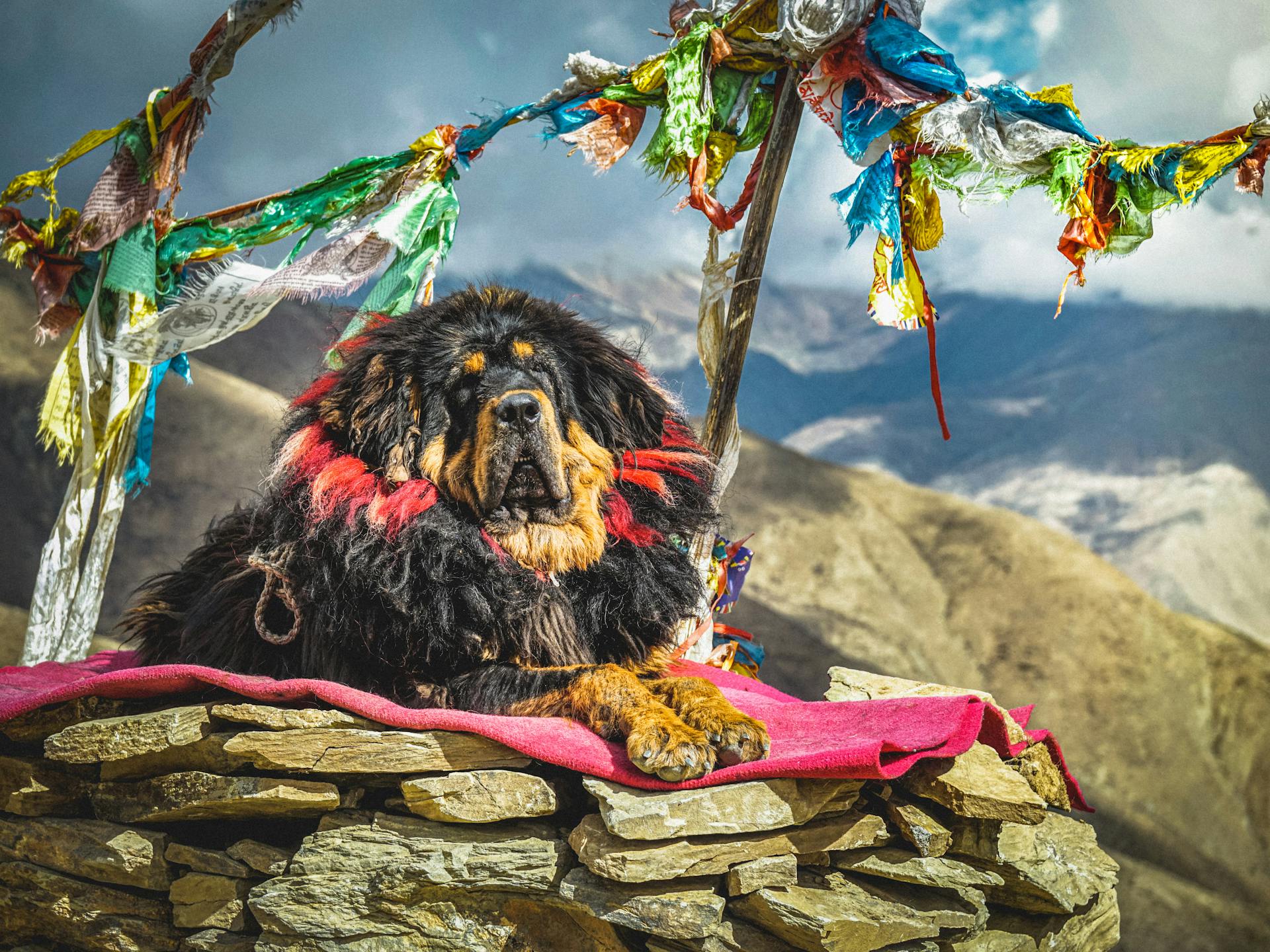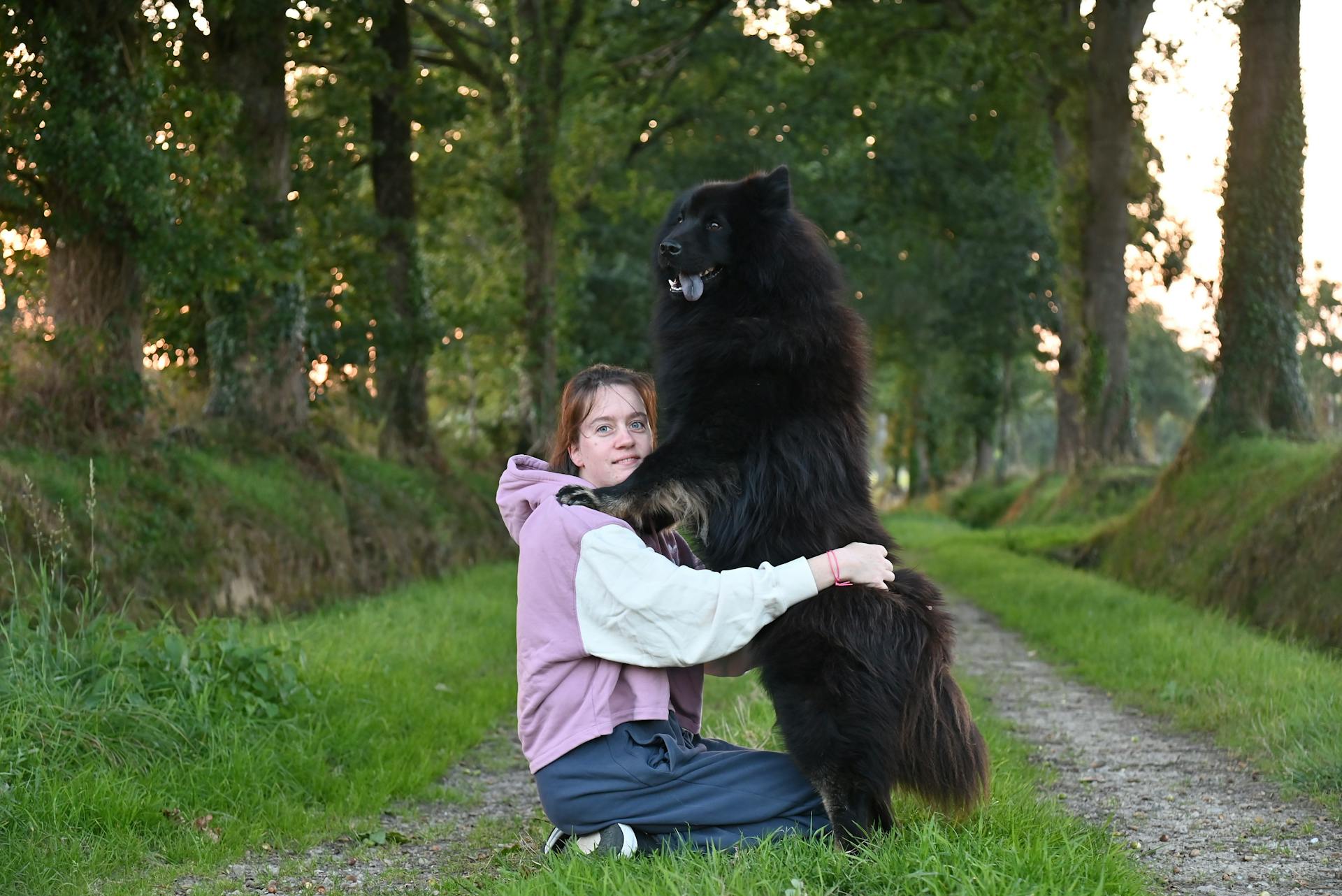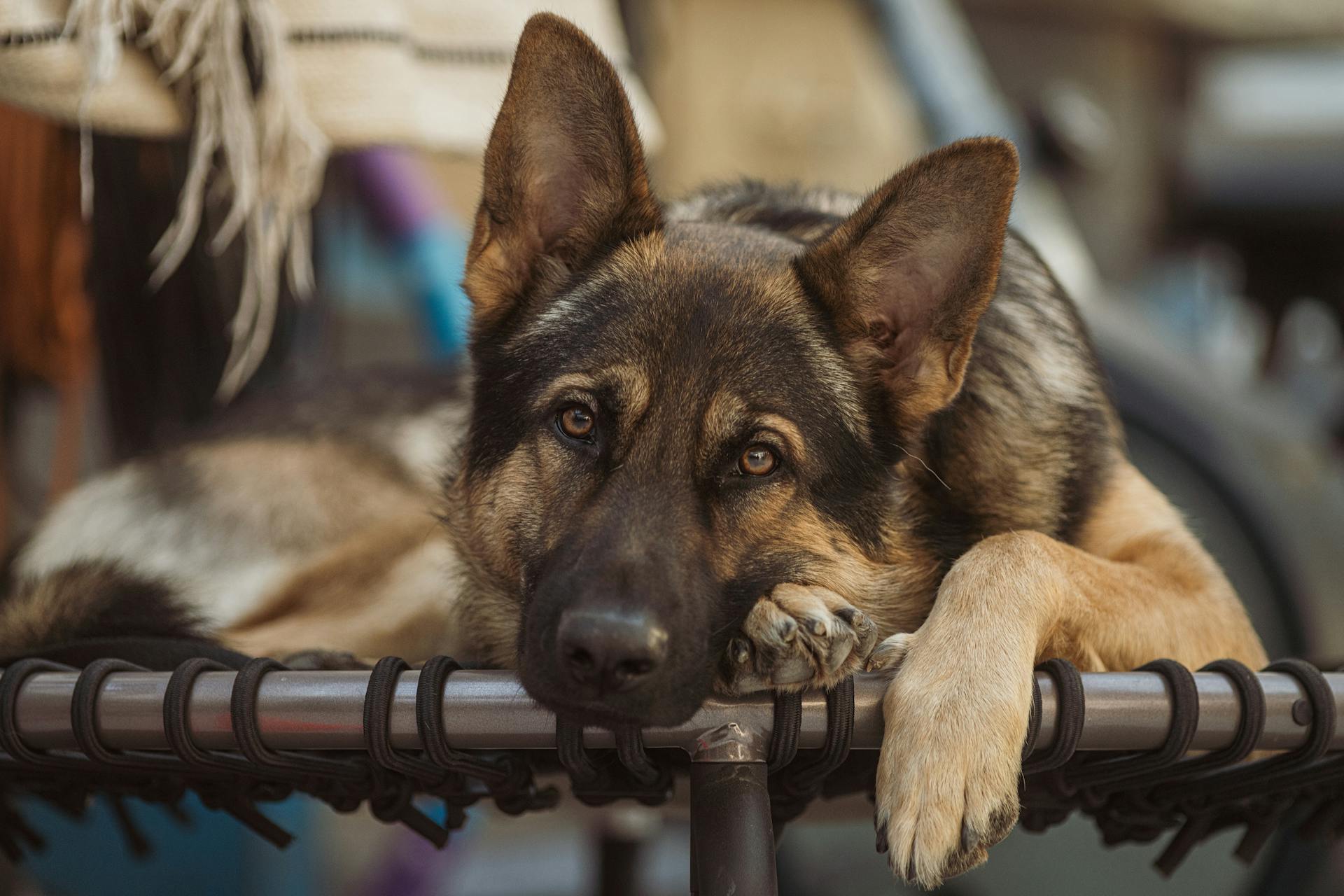
The Tibetan Mastiff and Caucasian Shepherd are two powerful breeds that have been used for centuries as guard dogs and working animals. They're both massive in size, with the Tibetan Mastiff weighing up to 160 pounds and the Caucasian Shepherd weighing up to 140 pounds.
Their thick coats help protect them from harsh climates and make them well-suited for cold weather. The Tibetan Mastiff has a distinctive double coat, while the Caucasian Shepherd has a thick, coarse coat.
Both breeds are highly intelligent and trainable, but they can be strong-willed and independent at times. They require consistent training and socialization from an early age to become well-behaved adult dogs.
Breed History
The Caucasian Shepherd Dog has a rich and complex history that spans over 2,000 years, with some experts believing they originated from wolves that were domesticated, while others think they descended from sheepdogs that migrated from Tibet.
They hail from the Caucasus Mountain region and have been invaluable companions to shepherds for centuries, guarding flocks of sheep and their owners from wildlife like wolves, jackals, and bears.
The breed developed in Georgia and is recognized by most kennel clubs today, with many different variants emerging due to the vastness of the Caucasus Mountain region.
The Caucasian Shepherd Dog was also used by the communist USSR as prisoner guard dogs and by East Germany as border patrol dogs along the Berlin Wall.
Today, they are mostly family companions, watchdogs, and property guardians, but they still need early socialization and firm training to avoid incidents due to their cautious and sometimes aggressive traits.
Their history is intertwined with that of the Tibetan Mastiff, which is believed to be related to the Caucasian Shepherd Dog, although they have separate histories.
Health and Care
The Tibetan Mastiff and Caucasian Shepherd are both large breeds that require regular care and attention to stay healthy. Both breeds are prone to joint and skeletal problems, including hip and elbow dysplasia, which can lead to mobility issues and painful arthritis.
The Tibetan Mastiff is also at risk of Canine Inherited Demyelinative Neuropathy, a genetic disease that can cause paralysis. Regular veterinary check-ups are crucial to monitor their health.
To keep your Tibetan Mastiff or Caucasian Shepherd healthy, it's essential to monitor their weight and diet. Both breeds can be prone to obesity, which can lead to various health issues.
Here are some common health issues to look out for:
- Hip Dysplasia
- Elbow Dysplasia
- Bloat (Gastric Dilatation-Volvulus)
- Obesity
- Entropion
Regular grooming is also essential for both breeds. The Tibetan Mastiff has a thick coat that requires regular brushing to prevent matting, while the Caucasian Shepherd needs his nails clipped regularly to prevent breaking and injury.
By following these simple care tips, you can help your Tibetan Mastiff or Caucasian Shepherd live a long and healthy life.
Care
The Tibetan Mastiff and Caucasian Shepherd are both large breeds that require regular care to stay healthy and happy. They need to be fed a diet formulated for a giant breed with fairly low energy levels, and it's essential to stick to the recommended meal plan to prevent overeating and weight gain.
Their thick coats require regular brushing to prevent matting, and it's also crucial to check their eyes and ears for signs of infections or irritation. Regular grooming is a fun way to spend time with your dog and help prevent health issues.
Both breeds are prone to joint and skeletal conditions, such as hip and elbow dysplasia, so it's vital to only buy from reputable breeders who undergo the recommended pre-breeding health screenings. You should also keep an eye on their weight, as obesity is a significant issue with both breeds.
Here's a comparison of the average daily food consumption and weight gain potential for the Tibetan Mastiff, Caucasian Shepherd, and Georgian Shepherd Dog:
By following these care tips and being mindful of their specific needs, you can help your Tibetan Mastiff or Caucasian Shepherd live a long, healthy, and happy life.
Coat and Grooming
The Caucasian Shepherd Dog has a thick coat that requires regular brushing to prevent matting and shedding. They come in a variety of colors including gray, fawn, red, cream, tan, and solid white, with some having brindle or large patches of two or more colors.
Their coat is double-layered, with a fine and soft undercoat and a coarse and longer outer coat. The longer the hair, the more pronounced the mane is around their necks and the feathering is around their hind legs and tails.
They have a heavy shed once a year, which can be a challenge to manage. Bathing and extra brushing can help move this shedding along more quickly, but it's a big dog, so it's often best to just bathe them as needed or rely on a professional groomer.
Their thick coat should be brushed at least twice a week to remove loose or dead hairs.
Appearance and Size
The Caucasian Shepherd can weigh over 200 pounds, making it a giant breed, while the Tibetan Mastiff weighs between 70 and 150 pounds.
Both breeds have very fluffy coats that require regular grooming and lots of shedding. The Caucasian Shepherd comes in three coat variations, short, medium, and long, while the Tibetan Mastiff has one seriously fluffy coat.
They both have a double coat that keeps them warm in cold climates, but their low heat tolerance means they're not ideal for hot areas. The Caucasian Shepherd comes in a range of colors including gray, black, brown, and red, while the Tibetan Mastiff has two color varieties: reddish and black and brown.
For your interest: Black Mastiffs
Pictures
The Caucasian Shepherd Dog is a majestic sight to behold, with its thick coat and muscular build. Its size can vary, but on average, it stands between 24 and 32 inches tall at the shoulder.
Finding a reputable dog breeder is crucial in getting a dog that looks like this, as they prioritize breeding healthy, well-socialized puppies. They also screen their breeding stock for health problems.
The dog's thick coat is one of its defining features, and it requires regular grooming to prevent matting and tangling. Regular grooming is a must for this breed.
A reputable breeder will provide you with lifetime support, which is essential for a breed like the Caucasian Shepherd Dog that requires regular care and attention.
For another approach, see: Tibetan Mastiff Breeders
Appearance
The Caucasian Shepherd and Tibetan Mastiff are both massive dogs with thick coats that can make them appear even bigger than they are. The Caucasian Shepherd can weigh over 200 pounds, while the Tibetan Mastiff weighs between 70 and 150 pounds.
Their coats are incredibly fluffy, which means they shed a lot. The Caucasian Shepherd has three coat variations: short, medium, and long, while the Tibetan Mastiff has a single, seriously fluffy coat.
Both breeds have a double coat that keeps them warm in cold climates like the Caucasus or Himalayan mountains. This double coat is made up of a smooth undercoat and longer guard hairs on the outside.
The Caucasian Shepherd comes in a range of colors, including black, gray, brown, and red, often in a combination of these colors. The Tibetan Mastiff, on the other hand, has two color varieties: reddish and black and brown.
Their size and color can sometimes lead to mistaken identities, with the Caucasian Shepherd often being mistaken for a long-haired English Mastiff.
Expand your knowledge: Tibetan Mastiff Brown
Size
The Caucasian Shepherd and Tibetan Mastiff are both large breeds, but they have some key differences in terms of size.
The Caucasian Shepherd can grow up to 30 inches tall at the shoulders, while the Tibetan Mastiff is slightly shorter at around 24 inches.
If you live in an apartment, you'll want to consider the Caucasian Shepherd's height, as smaller adults might be as short as 26 inches.
The Tibetan Mastiff weighs up to 150 pounds, which is significantly more than the Caucasian Shepherd, which weighs between 100 and 170 pounds.
The Tibetan Mastiff's thick, fluffy coat contributes to its larger stature, making it a huge breed, while the Caucasian Shepherd is considered a gigantic breed.
Here's an interesting read: Tibetan Mastiff Mix Breed
Personality and Temperament
The Tibetan Mastiff has an independent streak, which can make them seem aloof at times. They're not shy, but they do take time to warm up to new people.
Their protective nature makes them excellent watchdogs, and they'll fiercely defend their family and home. However, they're not naturally aggressive and prefer to avoid conflict.
Tibetan Mastiffs are loyal companions and will form strong bonds with their family members. They're not overly affectionate, but you'll know you're in good hands with them around.
In terms of social needs, Tibetan Mastiffs have an average need for interaction, which means they're happy to spend time with their family but don't require constant attention.
Here's a comparison of the temperament traits of the Tibetan Mastiff, Caucasian Shepherd, and Georgian Shepherd Dog:
Tibetan Mastiffs are sensitive dogs that don't like irregular daily routines, noisy households, or frequent guest visits. They prefer a calm and predictable environment, which makes them well-suited for families with a stable routine.
Trainability and Intelligence
The Tibetan Mastiff is a highly intelligent breed, but it can be willful at times. This means they need early training to stay alert and responsive to commands.
Positive reinforcement is key when training a Tibetan Mastiff, as they can be sensitive to stern reprimands. Treats are a great way to kickstart their lessons, but be sure to use them only for training purposes to avoid weight gain.
The Tibetan Mastiff's intelligence requires consistent guidance, making it essential to establish a routine and stick to it. This breed is known to be quite easy to train, but patience is still necessary to teach them new tricks or commands.
Here's a comparison of the trainability and intelligence of the Tibetan Mastiff, Caucasian Shepherd, and Caucasian Ovcharka:
The Tibetan Mastiff's watchdog ability is one of its strongest assets, making it an excellent protector of its owner and property.
Energy and Activity
The Tibetan Mastiff and the Caucasian Shepherd are both relatively low-maintenance dogs when it comes to exercise, requiring only 45-60 minutes of walking per day to stretch their large legs.
They don't need intense exercise or interactive games, but rather a larger space to roam and patrol. In fact, they would much prefer a larger garden to call their own.
The Caucasian Ovcharka, on the other hand, is a bit more energetic and playful, making it a great companion for active families.

Here's a comparison of the three breeds' energy levels:
In terms of exercise need, the Tibetan Mastiff has an average exercise need, while the Caucasian Ovcharka has a minimal exercise need. This means that if you're looking for a low-maintenance dog, the Caucasian Ovcharka might be the best choice.
However, if you're looking for a dog that will keep up with your active lifestyle, the Tibetan Mastiff might be a better fit. Just be aware that they do require regular exercise to stay happy and healthy.
Overall, all three breeds are relatively laid-back and don't require a lot of intense exercise or activity. But if you do want to engage in some playtime, the Caucasian Ovcharka is definitely up for it!
Consider reading: Ovcharka Caucasian Shepherd
Adaptability and Independence
The Georgian Shepherd Dog, Tibetan Mastiff, and Caucasian Ovcharka are all relatively adaptable dogs, handling lifestyle changes and different living environments quite okay usually.
However, their ability to tolerate being left alone varies. The Georgian Shepherd Dog handles alone time quite well, but the Tibetan Mastiff and Caucasian Ovcharka are prone to panic, cry, bark, and whine when left alone by their owner.
Here's a brief comparison of their adaptability potential:
Guard Instinct
Both the Tibetan Mastiff and the Caucasian Shepherd are naturally protective breeds, developed to guard livestock and their owners. They exhibit extremely similar behaviors due to their shared purpose.
The Tibetan Mastiff was bred in the Himalayas and surrounding regions to protect cattle and sheep, while the Caucasian Shepherd was developed in the Caucasian mountains to safeguard flocks of sheep and shepherds.
The Caucasian Shepherd has a higher need for protection and is always vigilant when on its property, making it a more intense guardian. The Tibetan Mastiff, on the other hand, is a bit more laid-back and disinterested in guarding its area.
Both breeds are tolerant of hot temperatures, with the Tibetan Mastiff excelling in this area.
Choosing and Purchasing
If you're considering bringing a Tibetan Mastiff or a Caucasian Shepherd into your family, you'll want to think about the cost. The Georgian Shepherd Dog is the most affordable option, with prices ranging from $1500 to $3000.
The Tibetan Mastiff is a bit pricier, with costs between $2500 and $3500. On the other hand, the Caucasian Shepherd Dog is a good middle ground, with prices between $1500 and $2500.
Availability is also something to consider. If you're looking for a dog that's easy to find, the Tibetan Mastiff is a good choice, as it's relatively common and easy to get. The Georgian Shepherd Dog is also widely available, making it a great option if you're looking for a dog that's easy to find. The Caucasian Shepherd Dog, on the other hand, is a bit harder to come by, but you may still be able to find one at a dog show.
Choosing the Right Breed
Choosing the right breed is a crucial decision when it comes to bringing a new furry friend home. Both the Tibetan Mastiff and Caucasian Shepherd are large breeds, with males tipping the scales at over 100 pounds.
Their size is just one factor to consider, as both breeds have unique temperaments. The Tibetan Mastiff is more active and playful, while the Caucasian Shepherd is bold, fearless, and loyal.
Obedience training is essential for both breeds, especially considering their historical roles as guardians and watchdogs. The Tibetan Mastiff's independent nature may require a more patient approach.
If you're looking for a low-maintenance pet, the Caucasian Shepherd might be a better fit, with a low energy level and average health. However, both breeds have average health and a similar lifespan of 10-12 years.
Here's a comparison of the two breeds:
Remember, both breeds are expensive, with prices starting at least $2,000 for a puppy with a respectable pedigree.
Price and Availability
When considering the price of a dog, it's essential to know what to expect. The cost of a Georgian Shepherd Dog can range from $1500 to $3000.
The Tibetan Mastiff is generally more expensive, with prices ranging from $2500 to $3500. This is a significant investment, but many people find it worth it for the loyalty and companionship they provide.

If you're on a tighter budget, the Georgian Shepherd Dog or Caucasian Ovcharka may be a more affordable option, with prices ranging from $1500 to $2500.
Here's a quick comparison of the prices and availability of these breeds:
This comparison can help you make an informed decision about which breed to choose and whether it fits within your budget.
Recognition and Background
The Tibetan Mastiff and Caucasian Shepherd are both impressive breeds with a rich history. The Tibetan Mastiff is recognized by the American Kennel Club as a Working breed, which they achieved in 2006.
The Caucasian Shepherd, on the other hand, is not recognized by the American Kennel Club. However, it is recognized by other organizations and kennel clubs, including the Federation Cynologique Internationale.
Here are some of the organizations that recognize the Caucasian Shepherd:
- American Canine Registry
- America's Pet Registry
- Dog Registry of America Inc.
- Federation Cynologique Internationale
- North American Purebred Registry, Inc.
- American Canine Association, Inc.
- Continental Kennel Club
- National Kennel Club
- New Zealand Kennel Club
Recognition
The Georgian Shepherd Dog, Tibetan Mastiff, and Caucasian Ovcharka have varying levels of recognition across different kennel clubs and organizations.

The American Kennel Club (AKC) recognizes the Tibetan Mastiff as a Working breed, but does not recognize the Georgian Shepherd Dog or the Caucasian Ovcharka.
The Federation Cynologique Internationale (FCI) recognizes the Tibetan Mastiff in the Pinscher and Schnauzer - Molossoid and Swiss Mountain and Cattledogs group, in the Molossian type section, but does not recognize the other two breeds.
The following organizations recognize the Georgian Shepherd Dog: American Canine Registry, America's Pet Registry, Dog Registry of America Inc., and North American Purebred Registry, Inc.
The following organizations recognize the Tibetan Mastiff: American Canine Registry, America's Pet Registry, Dog Registry of America Inc., Federation Cynologique Internationale, Kennel Club of Great Britain, North American Purebred Registry, Inc., American Canine Association, Inc., Continental Kennel Club, National Kennel Club, and New Zealand Kennel Club.
The following organizations recognize the Caucasian Ovcharka: American Canine Registry, America's Pet Registry, Dog Registry of America Inc., Federation Cynologique Internationale, North American Purebred Registry, Inc., American Canine Association, Inc., Continental Kennel Club, National Kennel Club, and Foundation Stock Service.
Suggestion: Caucasian Shepherd Kennel
Breed Backgrounds
The Caucasian Shepherd and the Tibetan Mastiff are two breeds that often get confused with each other due to their similarities.
Both breeds have separate histories, but it is believed that they are related to one another.
If you're interested in learning more about the Tibetan Mastiff, you can visit the Tibetan Mastiff Rescue website to learn about their work rehoming Tibetans in America.
The Caucasian Shepherd, on the other hand, does not have a dedicated website, but you can find information on their Facebook page, the Caucasian Shepherd Club of America.
Here's a comparison of the two breeds' physical characteristics:
The Caucasian Shepherd and the Tibetan Mastiff also share some similarities in their temperaments, with both breeds being described as having a bold and fearless nature.
Frequently Asked Questions
Is a Tibetan Mastiff the same as a Caucasian Shepherd?
No, a Tibetan Mastiff and a Caucasian Shepherd are distinct breeds, although they share similar guarding instincts. Both breeds were developed to protect livestock, but they have unique origins and characteristics.
Sources
- https://dogtime.com/dog-breeds/caucasian-shepherd-dog
- https://www.caninejournal.com/caucasian-shepherd-vs-tibetan-mastiff/
- https://www.hepper.com/tibetan-mastiff-vs-caucasian-shepherd/
- https://dogell.com/en/compare-dog-breeds/georgian-shepherd-dog-vs-tibetan-mastiff-vs-caucasian-ovcharka
- https://welovedoodles.com/tibetan-mastiff-vs-caucasian-shepherd/
Featured Images: pexels.com


